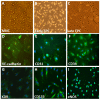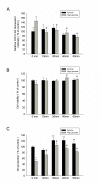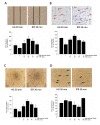Far infra-red therapy promotes ischemia-induced angiogenesis in diabetic mice and restores high glucose-suppressed endothelial progenitor cell functions
- PMID: 22894755
- PMCID: PMC3472269
- DOI: 10.1186/1475-2840-11-99
Far infra-red therapy promotes ischemia-induced angiogenesis in diabetic mice and restores high glucose-suppressed endothelial progenitor cell functions
Abstract
Background: Far infra-red (IFR) therapy was shown to exert beneficial effects in cardiovascular system, but effects of IFR on endothelial progenitor cell (EPC) and EPC-related vasculogenesis remain unclear. We hypothesized that IFR radiation can restore blood flow recovery in ischemic hindlimb in diabetic mice by enhancement of EPCs functions and homing process.
Materials and methods: Starting at 4 weeks after the onset of diabetes, unilateral hindlimb ischemia was induced in streptozotocin (STZ)-induced diabetic mice, which were divided into control and IFR therapy groups (n = 6 per group). The latter mice were placed in an IFR dry sauna at 34°C for 30 min once per day for 5 weeks.
Results: Doppler perfusion imaging demonstrated that the ischemic limb/normal side blood perfusion ratio in the thermal therapy group was significantly increased beyond that in controls, and significantly greater capillary density was seen in the IFR therapy group. Flow cytometry analysis showed impaired EPCs (Sca-1(+)/Flk-1(+)) mobilization after ischemia surgery in diabetic mice with or without IFR therapy (n = 6 per group). However, as compared to those in the control group, bone marrow-derived EPCs differentiated into endothelial cells defined as GFP(+)/CD31(+) double-positive cells were significantly increased in ischemic tissue around the vessels in diabetic mice that received IFR radiation. In in-vitro studies, cultured EPCs treated with IFR radiation markedly augmented high glucose-impaired EPC functions, inhibited high glucose-induced EPC senescence and reduced H(2)O(2) production. Nude mice received human EPCs treated with IFR in high glucose medium showed a significant improvement in blood flow recovery in ischemic limb compared to those without IFR therapy. IFR therapy promoted blood flow recovery and new vessel formation in STZ-induced diabetic mice.
Conclusions: Administration of IFR therapy promoted collateral flow recovery and new vessel formation in STZ-induced diabetic mice, and these beneficial effects may derive from enhancement of EPC functions and homing process.
Figures







Similar articles
-
Recovery from hind limb ischemia is less effective in type 2 than in type 1 diabetic mice: roles of endothelial nitric oxide synthase and endothelial progenitor cells.J Vasc Surg. 2009 Dec;50(6):1412-22. doi: 10.1016/j.jvs.2009.08.007. Epub 2009 Oct 17. J Vasc Surg. 2009. PMID: 19837544 Free PMC article.
-
Niacin improves ischemia-induced neovascularization in diabetic mice by enhancement of endothelial progenitor cell functions independent of changes in plasma lipids.Angiogenesis. 2012 Sep;15(3):377-89. doi: 10.1007/s10456-012-9267-z. Epub 2012 Mar 31. Angiogenesis. 2012. PMID: 22467057
-
Insulin modulates ischemia-induced endothelial progenitor cell mobilization and neovascularization in diabetic mice.Microvasc Res. 2011 Nov;82(3):227-36. doi: 10.1016/j.mvr.2011.09.006. Epub 2011 Sep 21. Microvasc Res. 2011. PMID: 21964072
-
Role of endothelial progenitor cells during ischemia-induced vasculogenesis and collateral formation.Microvasc Res. 2010 May;79(3):200-6. doi: 10.1016/j.mvr.2010.01.012. Epub 2010 Feb 6. Microvasc Res. 2010. PMID: 20144623 Free PMC article. Review.
-
Nitric oxide: a key factor behind the dysfunctionality of endothelial progenitor cells in diabetes mellitus type-2.Cardiovasc Res. 2011 Jul 1;91(1):9-15. doi: 10.1093/cvr/cvq412. Epub 2010 Dec 24. Cardiovasc Res. 2011. PMID: 21186243 Review.
Cited by
-
Far-infrared Ray-mediated Antioxidant Potentials are Important for Attenuating Psychotoxic Disorders.Curr Neuropharmacol. 2019;17(10):990-1002. doi: 10.2174/1570159X17666190228114318. Curr Neuropharmacol. 2019. PMID: 30819085 Free PMC article. Review.
-
Muscle Derived Stem Cells Stimulate Muscle Myofiber Repair and Counteract Fat Infiltration in a Diabetic Mouse Model of Critical Limb Ischemia.J Stem Cell Res Ther. 2016 Dec;6(12):370. doi: 10.4172/2157-7633.1000370. Epub 2016 Dec 26. J Stem Cell Res Ther. 2016. PMID: 28217409 Free PMC article.
-
Icariin reduces high glucose-induced endothelial progenitor cell dysfunction via inhibiting the p38/CREB pathway and activating the Akt/eNOS/NO pathway.Exp Ther Med. 2019 Dec;18(6):4774-4780. doi: 10.3892/etm.2019.8132. Epub 2019 Oct 25. Exp Ther Med. 2019. PMID: 31772646 Free PMC article.
-
Coordinated Activation of VEGF/VEGFR-2 and PPARδ Pathways by a Multi-Component Chinese Medicine DHI Accelerated Recovery from Peripheral Arterial Disease in Type 2 Diabetic Mice.PLoS One. 2016 Dec 8;11(12):e0167305. doi: 10.1371/journal.pone.0167305. eCollection 2016. PLoS One. 2016. PMID: 27930695 Free PMC article.
-
Rivaroxaban, a factor Xa inhibitor, improves neovascularization in the ischemic hindlimb of streptozotocin-induced diabetic mice.Cardiovasc Diabetol. 2015 Jun 16;14:81. doi: 10.1186/s12933-015-0243-y. Cardiovasc Diabetol. 2015. PMID: 26077117 Free PMC article.
References
-
- Rosengart TK, Lee LY, Patel SR, Sanborn TA, Parikh M, Bergman GW, Hachamovitch R, Szulc M, Kligfield PD, Okin PM, Hahn RT, Devereux RB, Post MR, Hackett NR, Foster T, Grasso TM, Lesser ML, Isom OW, Crystal RG. Angiogenesis gene therapy: phase I assessment of direct intramyocardial administration of an adenovirus vector expressing VEGF121 cDNA to individuals with clinically significant severe coronary artery disease. Circulation. 1999;100(5):468–474. doi: 10.1161/01.CIR.100.5.468. - DOI - PubMed
-
- Nathan DM, Cleary PA, Backlund JY, Genuth SM, Lachin JM, Orchard TJ, Raskin P, Zinman B. Diabetes Control and Complications Trial/Epidemiology of Diabetes Interventions and Complications (DCCT/EDIC) Study Research Group: Intensive diabetes treatment and cardiovascular disease in patients with type 1 diabetes. N Engl J Med. 2005;353(25):2643–2653. - PMC - PubMed
-
- Adeghate E. Molecular and cellular basis of the etiology and management of diabetic cardiomyopathy: a short review. Mol Cell Biochem. 2004;261(1–2):187–191. - PubMed
Publication types
MeSH terms
Substances
LinkOut - more resources
Full Text Sources
Other Literature Sources
Medical
Research Materials

